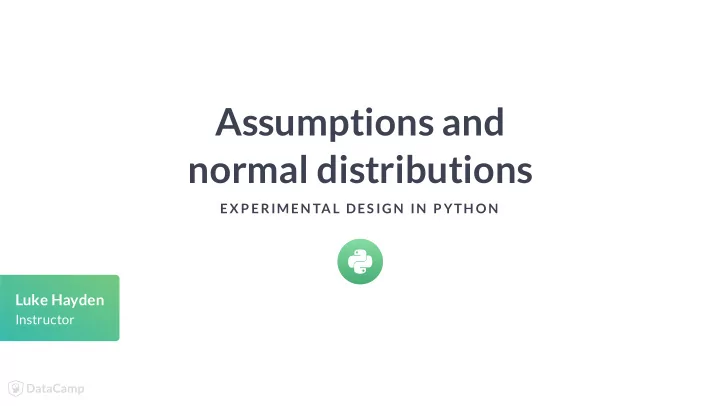

Assumptions and normal distributions EX P ERIMEN TAL DES IGN IN P YTH ON Luke Hayden Instructor
Summary stats Mean Sum divided by count Median Half of values fall above and below the median Mode Value that occurs most often Standard deviation Measure of variability EXPERIMENTAL DESIGN IN PYTHON
Normal distribution EXPERIMENTAL DESIGN IN PYTHON
Sample distribution print(p9.ggplot(countrydata)+ p9.aes(x= 'Life_exp')+ p9.geom_density(alpha=0.5)) EXPERIMENTAL DESIGN IN PYTHON
Accessing summary stats Mean Median print(countrydata.Life_exp.mean()) print(countrydata.Life_exp.median()) 73.68201058201058 76.0 Mode print(countrydata.Life_exp.mode()) 78.4 EXPERIMENTAL DESIGN IN PYTHON
Normal distribution EXPERIMENTAL DESIGN IN PYTHON
Q-Q (quantile-quantile) plot Normal probability plot Use Distribution �t expected (normal) distribution? Graphical method to assess normality Basis Compare quantiles of data with theoretical quantiles predicted under distribution EXPERIMENTAL DESIGN IN PYTHON
Creating a Q-Q plot from scipy import stats import plotnine as p9 tq = stats.probplot(countrydata.Life_exp, dist="norm") df = pd.DataFrame(data = {'Theoretical Quantiles': tq[0][0], "Ordered Values": countrydata.Life_exp.sort_values() }) print(p9.ggplot(df)+ p9.aes('Theoretical Quantiles', "Ordered Values") +p9.geom_point()) EXPERIMENTAL DESIGN IN PYTHON
Q-Q plot for sample Distribution Q-Q plot EXPERIMENTAL DESIGN IN PYTHON
Let's practice! EX P ERIMEN TAL DES IGN IN P YTH ON
Testing for normality EX P ERIMEN TAL DES IGN IN P YTH ON Luke Hayden Instructor
Testing for normality Normal distribution Mean, median, and mode are equal Symmetrical Crucial assumption of certain tests Approach T est for normality EXPERIMENTAL DESIGN IN PYTHON
Shapiro-Wilk test Basis from scipy import stats T est for normality shapiro = stats.shapiro(my_sample) Based on same logic as Q-Q plot print(shapiro) Use 1) T est normality of each sample 2) Choose test/approach 3) Perform hypothesis test EXPERIMENTAL DESIGN IN PYTHON
Shapiro-Wilk test example EXPERIMENTAL DESIGN IN PYTHON
Implementing a Shapiro-Wilk test from scipy import stats shapiro = stats.shapiro(countrydata.Life_exp) print(shapiro) (0.39991819858551025, 6.270842690066813e-26) EXPERIMENTAL DESIGN IN PYTHON
Test assumptions Tests based on assumption of normality Student's t-test (one and two-sample) Paired t-test ANOVA Normality test T est by group EXPERIMENTAL DESIGN IN PYTHON
Normality and test choice Sample size & sample mean Large sample size: sample mean approaches population mean Small sample sizes Important that normality assumption not violated Large sample sizes Importance of normality is relaxed EXPERIMENTAL DESIGN IN PYTHON
Let's practice! EX P ERIMEN TAL DES IGN IN P YTH ON
Non-parametric tests: Wilcoxon rank- sum test EX P ERIMEN TAL DES IGN IN P YTH ON Luke Hayden Instructor
When assumptions don't hold T ests are based on assumptions about data Approach Normality: assumption underlying t-test Non-parametric tests Violation of assumptions "Looser" constraints T est no longer valid EXPERIMENTAL DESIGN IN PYTHON
Parametric vs non-parametric tests Parametric tests Non-parametric tests Make many assumptions Make few assumptions Population modeled by distribution with No �xed population parameters �xed parameters (eg: normal) Used when data doesn't �t these Sensitivity distributions Sensitivity Higher Hypotheses Lower Hypotheses More speci�c Less speci�c EXPERIMENTAL DESIGN IN PYTHON
Wilcoxon rank-sum vs t-test Student's t-test Wilcoxon rank-sum test Parametric Non-parametric Hypothesis Hypothesis mean sample A == mean sample B? random sample A > random sample B Assumptions Assumptions Relies on normality No sensitive to distribution shape Sensitivity Sensitivity Higher Slightly lower EXPERIMENTAL DESIGN IN PYTHON
Wilcoxon rank-sum test example EXPERIMENTAL DESIGN IN PYTHON
Implementing a Wilcoxon rank-sum test from scipy import stats Sample_A = df[df.Fertilizer == "A"] Sample_B = df[df.Fertilizer == "B"] wilc = stats.ranksums(Sample_A, Sample_B) print(wilc) RanksumsResult(statistic=16.085203659039184, pvalue=3.239851573227159e-58) EXPERIMENTAL DESIGN IN PYTHON
Wilcoxon signed-rank test Non-parametric equivalent to paired t-test 2017 yield 2018 yield T ests if ranks differ across pairs 60.2 63.2 12 15.6 13.8 14.8 91.8 96.7 50 53 45 47 EXPERIMENTAL DESIGN IN PYTHON
Wilcoxon signed-rank test example from scipy import stats yields2018= [60.2, 12, 13.8, 91.8, 50, 45,32, 87.5, 60.1,88 ] yields2019 = [63.2, 15.6, 14.8, 96.7, 53, 47, 31.3, 89.8, 67.8, 90] wilcsr = stats.wilcoxon(yields2018, yields2019) print(wilcsr) WilcoxonResult(statistic=1.0, pvalue=0.00683774356850919) EXPERIMENTAL DESIGN IN PYTHON
Let's practice! EX P ERIMEN TAL DES IGN IN P YTH ON
More non- parametric tests: Spearman correlation EX P ERIMEN TAL DES IGN IN P YTH ON Luke Hayden Instructor
Correlation Basis Relate one continuous or ordinal variable to another Will variation in one predict variation in the other? Pearson correlation Based on a linear model EXPERIMENTAL DESIGN IN PYTHON
Pearson vs Spearman correlation Pearson correlation Spearman correlation Parametric Non-parametric Based on raw values Based on ranks Sensitive to outliers Robust to outliers Assumes: Assumes: Linear, monotonic relationship Monotonic relationship Effect measure Effect measure Pearson's r Spearman's rho EXPERIMENTAL DESIGN IN PYTHON
Pearson vs Spearman correlation Pearson's r: 1, Spearman's rho = 1 EXPERIMENTAL DESIGN IN PYTHON
Pearson vs Spearman correlation Pearson's r: -1, Spearman's rho = -1 EXPERIMENTAL DESIGN IN PYTHON
Pearson vs Spearman correlation Pearson's r: 0.915, Spearman's rho = 1 EXPERIMENTAL DESIGN IN PYTHON
Pearson vs Spearman correlation Pearson's r: 0.0429, Spearman's rho = 0.0428 EXPERIMENTAL DESIGN IN PYTHON
Spearman correlation example EXPERIMENTAL DESIGN IN PYTHON
Implementing a Spearman correlation from scipy import stats pearcorr = stats.pearsonr(oly.Height, oly.Weight) print(pearcorr) (0.6125605419882442, 7.0956520885987905e-190) spearcorr = stats.spearmanr(oly.Height, oly.Weight) print(spearcorr) SpearmanrResult(correlation=0.728877815423366, pvalue=1.4307959767478955e-304) EXPERIMENTAL DESIGN IN PYTHON
Let's practice! EX P ERIMEN TAL DES IGN IN P YTH ON
Summary EX P ERIMEN TAL DES IGN IN P YTH ON Luke Hayden Instructor
What you've learned Chapter 1 Exploratory data analysis & hypothesis testing Chapter 2 Dealing with multiple factors Chapter 3 Type I and II errors and the power-sample size-effect size relationship Chapter 4 Dealing with assumptions of tests EXPERIMENTAL DESIGN IN PYTHON
Uncertainty is a theme of statistics Uncertainty is always present We can't expect absolute certainty Approach Quantify our uncertainty Assess likelihood of competing hypotheses Methods may rest on unproven assumptions EXPERIMENTAL DESIGN IN PYTHON
Embrace uncertainty! EX P ERIMEN TAL DES IGN IN P YTH ON
Recommend
More recommend